Study on Overburden Movement and Fissure Evolution Law of Protective Layer Mining in Shallow Coal Seam
Abstract
:1. Introduction
2. Engineering Background
3. Motion Analysis of Roof and Floor Overlying Rock in Goaf
3.1. Influence of Mining on Overlying Strata Separation
3.2. Influence of Mining on Underlying Strata
3.3. Height Determination of Falling Zone and Fracture Zone
4. Numerical Simulation Analysis
4.1. Establishment of Numerical Model
4.2. Analysis of Collapse Characteristics of Working Face Advancing at Different Distances
4.3. Analysis of Fracture Evolution Law of Working Face Advancing at Different Distances
4.4. Analysis of Roof and Floor Displacement at Different Distances of Working Face Propulsion
4.5. Pressure Relief Characteristics Analysis of Protected Layer Mining
4.5.1. Pressure Relief Rate Analysis of Protected Layer Mining
4.5.2. Analysis of Expansion Rate of Protected Layer in Mining
5. Rocks Like Materials Analysis
5.1. Pressure Relief Characteristics Analysis of Protected Layer Mining
- (1)
- Clean the shelves of the experimental model and remove all the steel plates on one side.
- (2)
- Calculate the model material ratio of each rock layer, weigh the corresponding mass and stir evenly, and add an appropriate amount of water to ensure that the rock layer is not affected by dry humidity.
- (3)
- Pour the mixed material into the model shelf, smooth it evenly, and scatter mica powder to the thickness of 1 cm to achieve the effect of stratification.
- (4)
- Lay each layer of coal in accordance with the steps in (3) from bottom to top.
- (5)
- After completing the above steps, the model can be placed in the natural environment for a week, and the front and rear steel plates are then removed in accordance with this until they are completely removed.
- (6)
- Finally, heavy objects such as iron blocks are placed on the model to simulate the dead weight and buried depth pressure of overlying strata, so as to achieve the best experimental effect. The final object is shown in Figure 15.
- (7)
- Install a fixed digital image correlation (DIC), as shown in Figure 16.
5.2. Analysis of Similarity Simulation Results
- (1)
- The 1# coal seam after excavation, the upper and lower strata fracture density with the advancement facing forward and becoming bigger, and the influence of the overburden is slightly greater than the impact on the underlying strata.
- (2)
- Under the influence of coal mining, the upper and lower strata of the protective layer move in the direction of the goaf. The closer it is to the goaf, the larger its displacement is, with the maximum displacement appearing in the middle of the goaf, indicating that the region produces the most fractures and is influenced by mining.
- (3)
- It can be seen from the displacement diagram that the maximum downward caving distance of the roof of the protective layer is 3 cm, which is 3 m according to the similarity ratio, and the maximum displacement point is approximately 6–7 cm away from the bottom plate, indicating that the height of the caving zone is approximately 6–7 m after the mining of the protective layer, which is roughly the same as the theoretical analysis.
- (4)
- As can be seen from the strain diagram, the maximum strain is 11.4, and the maximum strain point is approximately 20–21 cm away from the floor, so the height of the fracture zone is approximately 13–15 m, which is roughly the same as the theoretical analysis.
6. Engineering Application
6.1. The Original Gas Condition of the Protected Layer
6.2. Gas Changes in the Protected Layer
6.2.1. Investigation of Residual Gas Pressure in Protected Layer
6.2.2. Investigation of Residual Gas Content in Protected Layer
7. Conclusions
- (1)
- Through the theoretical analysis of the overburden movement of the mined-out area, a separation model of the overlying rock layer of the mined-out area was established, with the height of the caving zone calculated as 4.70~9.70 m, and the height of the fracture zone as 6.46~19.46 m.
- (2)
- UDEC numerical simulation was used to analyze the mining of the protective layer, and it was found that the roof directly began to collapse when the working face advanced to 30 m, and when the working face advanced to 50 m, the overburden was first pressed. With the advancement of the working face, the cracks produced by the overburden initially increased, then the cracks were continuously compacted by the collapsed rock layer, which mainly existed at both ends of the working face. Affected by mining, the overlying rock layer moved downwards, the underlying rock layer bulged upwards, and the rock layers all moved to the working face. The protected layer was subjected to pressure relief due to the mining of the protective layer, and the pressure relief rate of the protected layer was 0.2~0.8. Furthermore, the overall expansion rate of the protected layer was greater than the requirements of the “Detailed Rules for Prevention of Coal and Gas Outbursts” for coal mines, indicating that the mining of the protected layer was beneficial to gas drainage.
- (3)
- Measured using strain and displacement cloud maps, the height of the caving zone was 6–7 m and the height of the fracture zone was 13–15 m, which is consistent with the theoretical analysis results.
- (4)
- Through the investigation of the residual gas pressure and content of the protected layer, it was found that the protected coal seam was affected by the mining of the coal mining face of the upper protective layer. The gas pressure dropped to 50.7% of the original gas pressure of the coal seam, with a decrease rate of 49.3%. The residual gas content decreased by 68.67%, and the average gas concentration in the return air lane was 0.31%. In line with national regulations, this meets the national standard, which requires that its value be less than or equal to 1%.
Author Contributions
Funding
Institutional Review Board Statement
Informed Consent Statement
Data Availability Statement
Acknowledgments
Conflicts of Interest
References
- Zhu, H.; Fang, S.; Huo, Y.; Guo, J.; Wu, Y.; Hu, L. Study of the Dynamic Development Law of Overburden Breakage on Mining Faces. Sci. Rep. 2020, 10, 6555. [Google Scholar] [CrossRef] [PubMed] [Green Version]
- Qian, M.G.; Miu, X.X.; Xu, J.L. Theoretical Research on the Key Stratum in Strata Control. J. China Coal Soc. 1996, 3, 2–7. [Google Scholar]
- Zuo, J.P.; Sun, Y.J.; Qian, M.G. Movement mechanism and analogous hyperbola model of overlying strata with thick alluvium. J. China Coal Soc. 2017, 42, 1372–1379. [Google Scholar]
- Jena, S.K.; Lokhande, R.D.; Pradhan, M.; Kumar, N. Development of a model to estimate strata behavior during bord and pillar extraction in underground coal mining. Arab. J. Geosci. 2019, 12, 242. [Google Scholar] [CrossRef]
- Kong, D.Z.; Cheng, Z.B.; Zheng, S.S. Study on the failure mechanism and stability control measures in a large-cutting-height coal mining face with a deep-buried seam. Bull. Eng. Geol. Environ. 2019, 78, 6143–6157. [Google Scholar] [CrossRef]
- Kong, D.Z.; Pu, S.J.; Cheng, Z.H.; Wu, G.Y.; Liu, Y. Coordinated Deformation Mechanism of the Top Coal and Filling Body of Gob-Side Entry Retaining in a Fully Mechanized Caving Face. Int. J. Géoméch. 2021, 21, 04021030. [Google Scholar] [CrossRef]
- Kumar, A.; Kumar, D.; Singh, A.K.; Ram, S.; Kumar, R.; Gautam, A.; Singh, R.; Singh, A.K. Roof sagging limit in an early warning system for safe coal pillar extraction. Int. J. Rock Mech. Min. Sci. 2019, 123, 104131. [Google Scholar] [CrossRef]
- Jena, S.K.; Ritesh, D.L.; Manoj, P.; Kuldip, P. Analysis of strata control monitoring in underground coal mine for apprehension of strata movement. In Proceedings of the Conference on Recent Advances in Rock Enginering (Rare 2016), Bengaluru, India, 16–18 November 2016; Volume 91, pp. 505–511. [Google Scholar]
- Yu, Q.X.; Cheng, Y.P.; Jiang, C.L.; Zhou, S.N. Principles and applications of exploitation of coal and pressure relief gas in thick and high-gas seams. Zhongguo Kuangye Daxue Xuebao/J. China Univ. Min. Technol. 2004, 33, 127–131. [Google Scholar]
- Wang, L.; Lu, Z.; Chen, D.-P.; Liu, Q.-Q.; Chu, P.; Shu, L.-Y.; Ullah, B.; Wen, Z.-J. Safe strategy for coal and gas outburst prevention in deep-and-thick coal seams using a soft rock protective layer mining. Saf. Sci. 2020, 129, 104800. [Google Scholar] [CrossRef]
- Xue, Y.; Gao, F.; Gao, Y.; Cheng, H.; Liu, Y.; Hou, P.; Teng, T. Quantitative evaluation of stress-relief and permeability-increasing effects of overlying coal seams for coal mine methane drainage in Wulan coal mine. J. Nat. Gas Sci. Eng. 2016, 32, 122–137. [Google Scholar] [CrossRef]
- Zhang, R.; Cheng, Y.; Zhou, H.; Yuan, L.; Li, W.; Liu, Q.; Jin, K.; Tu, Q. New insights into the permeability-increasing area of overlying coal seams disturbed by the mining of coal. J. Nat. Gas Sci. Eng. 2018, 49, 352–364. [Google Scholar] [CrossRef]
- Cheng, X.; Zhao, G.; Li, Y.; Meng, X.; Tu, Q. Key technologies and engineering practices for soft-rock protective seam mining. Int. J. Min. Sci. Technol. 2020, 30, 889–899. [Google Scholar] [CrossRef]
- Wang, L.; Chen, X.; Wang, Z.; Xu, S.; Xu, Q. Extending the protection range in protective seam mining under the influence of gas drainage. J. S. Afr. Inst. Min. Metall. 2020, 120, 211–220. [Google Scholar] [CrossRef]
- He, A.; Fu, H.; Huo, B.; Fan, C. Permeability Enhancement of Coal Seam by Lower Protective Layer Mining for Gas Outburst Prevention. Shock Vib. 2020, 2020, 8878873. [Google Scholar] [CrossRef]
- Xu, G.-S.; Li, H.-G.; Li, D.-H.; Zhang, Y.-B. Method to Calculate Mining-Induced Fracture Based on the Movement and Deformation of Overburden Strata. Shock Vib. 2021, 2021, 9965466. [Google Scholar] [CrossRef]
- Fu, W. Determination Method of Caving & Fracture Zone Height for Gas Drainage by High Level Borehole. Coal Technol. 2008, 27, 75–76. [Google Scholar]
- Sun, Y.; Zuo, J.; Karakus, M.; Wang, J. Investigation of movement and damage of integral overburden during shallow coal seam mining. Int. J. Rock Mech. Min. Sci. 2019, 117, 63–75. [Google Scholar] [CrossRef]
- Sun, Y.; Zuo, J.; Karakus, M.; Wen, J. A Novel Method for Predicting Movement and Damage of Overburden Caused by Shallow Coal Mining. Rock Mech. Rock Eng. 2020, 53, 1545–1563. [Google Scholar] [CrossRef]
- Shang, Y.; Wu, G.; Liu, Q.; Kong, D.; Li, Q. The Drainage Horizon Determination of High Directional Long Borehole and Gas Control Effect Analysis. Adv. Civ. Eng. 2021, 2021, 3370170. [Google Scholar] [CrossRef]
- Zhang, Y. Distribution law of floor stress during mining of the upper protective coal seam. Sci. Prog. 2020, 103, 0036850420930982. [Google Scholar] [CrossRef]
- Zhou, G.L.; Xu, T.; Konietzky, H.; Zhu, W.; Heng, Z.; Yu, X.Y.; Zhao, Y. An improved grain-based numerical manifold method to simulate deformation, damage and fracturing of rocks at the grain size level. Eng. Anal. Bound. Elem. 2021, 134, 107–116. [Google Scholar] [CrossRef]
- Lu, J.; Jiang, C.; Jin, Z.; Wang, W.; Zhuang, W.; Yu, H. Three-dimensional physical model experiment of mining-induced deformation and failure characteristics of roof and floor in deep underground coal seams. Process Saf. Environ. Prot. 2021, 150, 400–415. [Google Scholar] [CrossRef]
- Tan, L.; Ren, T.; Dou, L.; Yang, X.; Qiao, M.; Peng, H. Analytical stress solution and mechanical properties for rock mass containing a hole with complex shape. Theor. Appl. Fract. Mech. 2021, 114, 103002. [Google Scholar] [CrossRef]
- Wu, H.; Dai, B.; Cheng, L.; Lu, R.; Zhao, G.; Liang, W. Experimental Study of Dynamic Mechanical Response and Energy Dissipation of Rock Having a Circular Opening Under Impact Loading. Mining Metall. Explor. 2021, 38, 1111–1124. [Google Scholar] [CrossRef]
- Wu, Q.; Jiang, L.; Wu, Q.; Xue, Y.; Gong, B. A study on the law of overlying strata migration and separation space evolution under hard and thick strata in underground coal mining by similar simulation. DYNA 2018, 94, 175–181. [Google Scholar] [CrossRef] [Green Version]
- Kong, D.Z.; Xiong, Y.; Cheng, Z.B.; Wang, N.; Wu, G.Y.; Liu, Y. Stability analysis of coal face based on coal face-support-roof system in steeply inclined coal seam. Geomech. Eng. 2021, 25, 233–243. [Google Scholar]
- Fu, J.; Wen, G.; Sun, H.; Yang, X. Study on the shear movement law of overlying strata by slice mining. Energy Sci. Eng. 2020, 8, 2335–2351. [Google Scholar] [CrossRef] [Green Version]
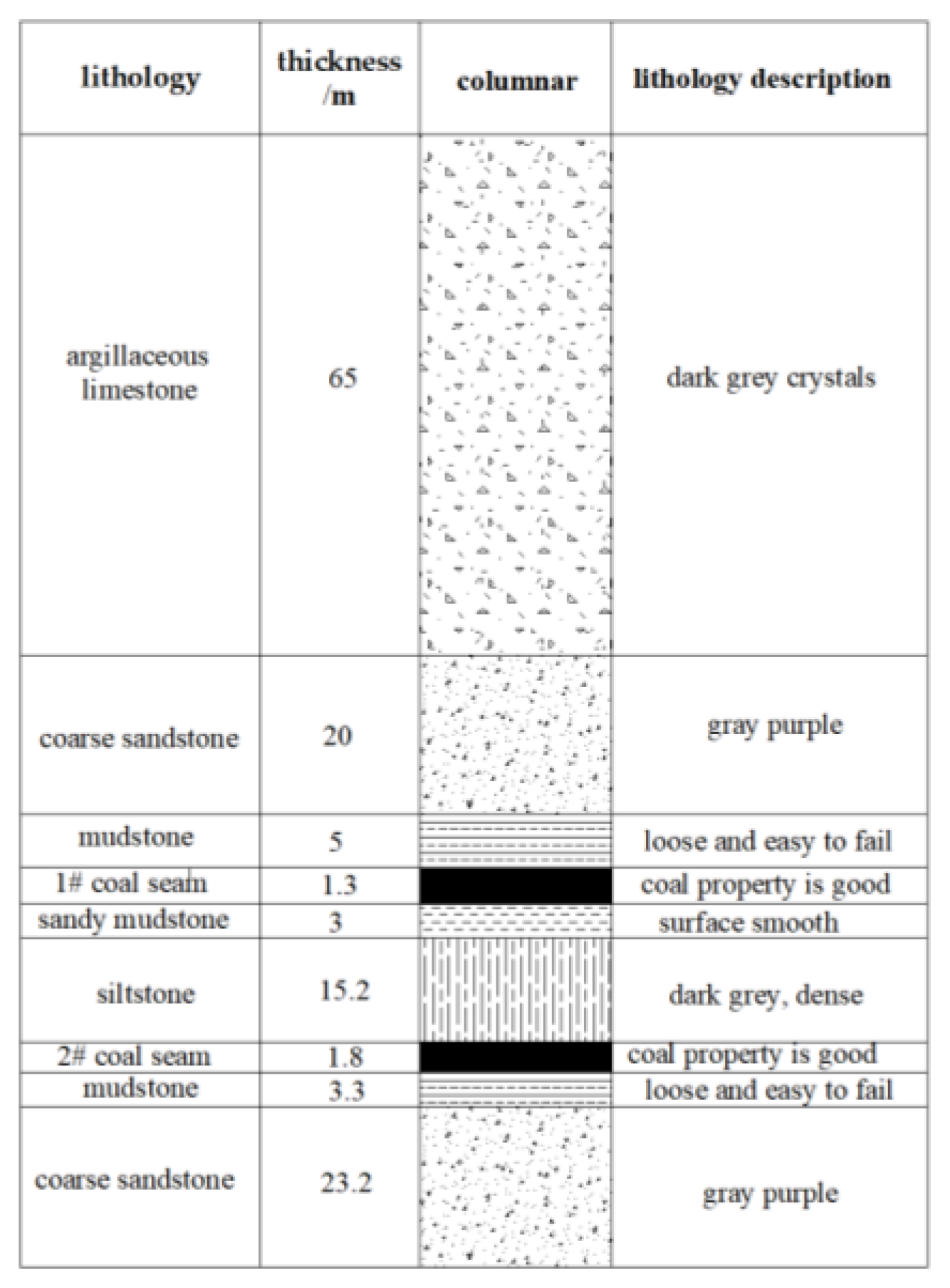
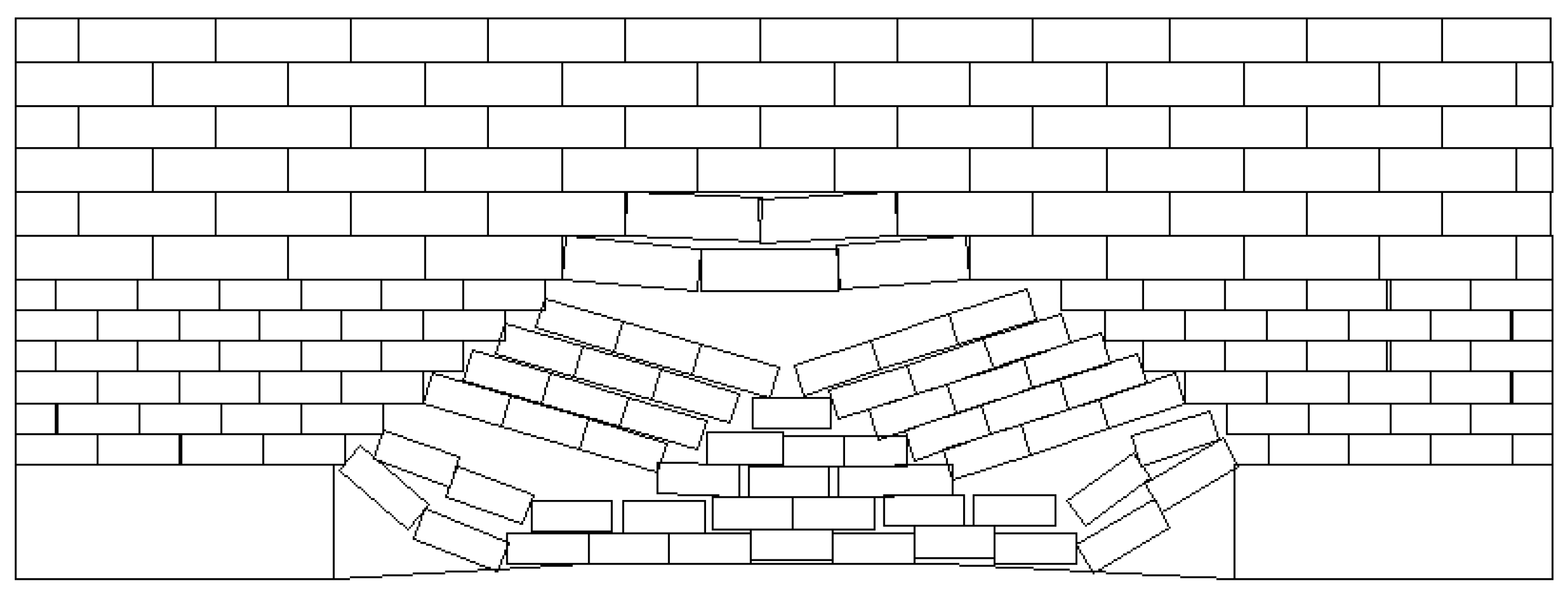
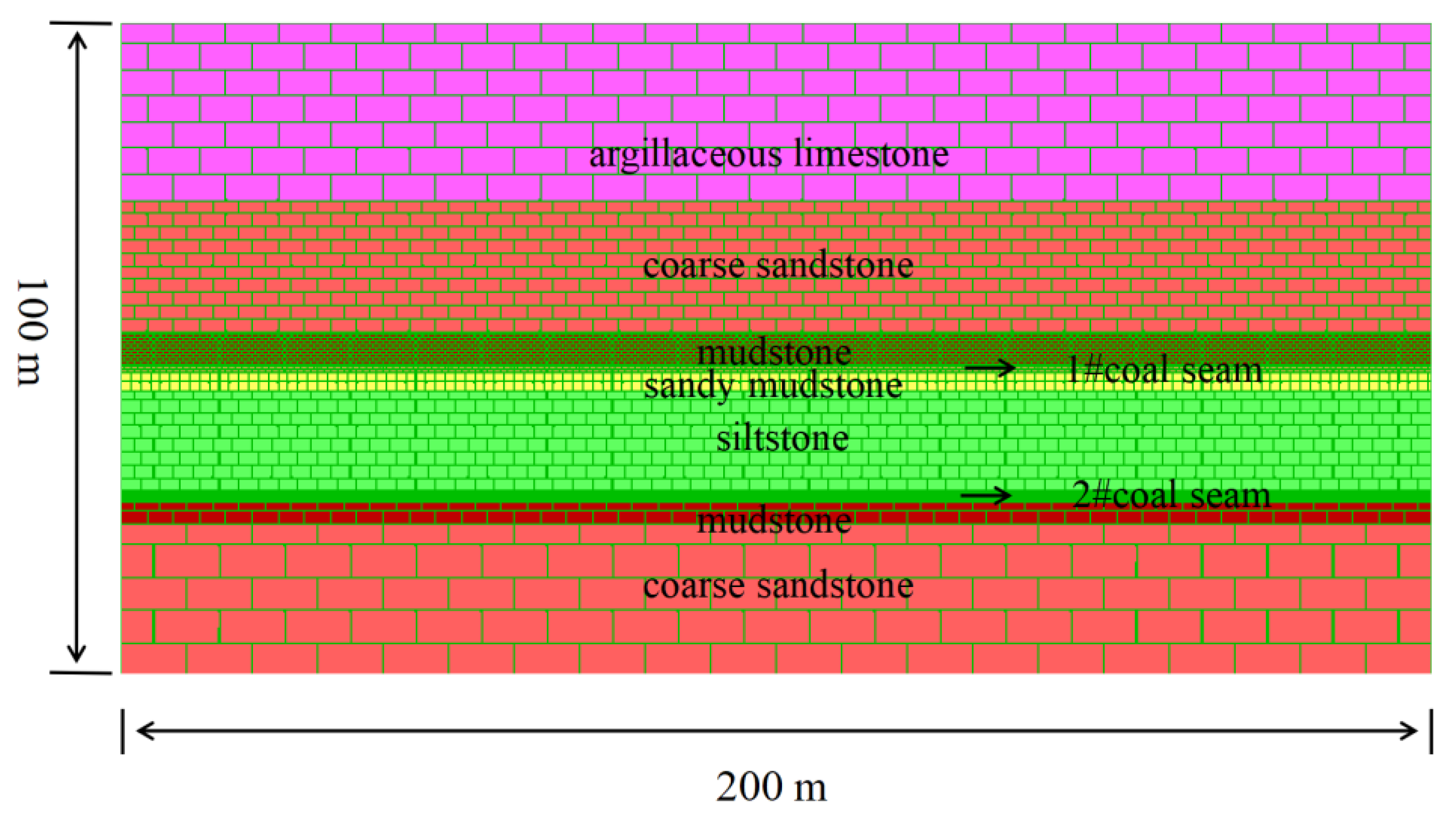

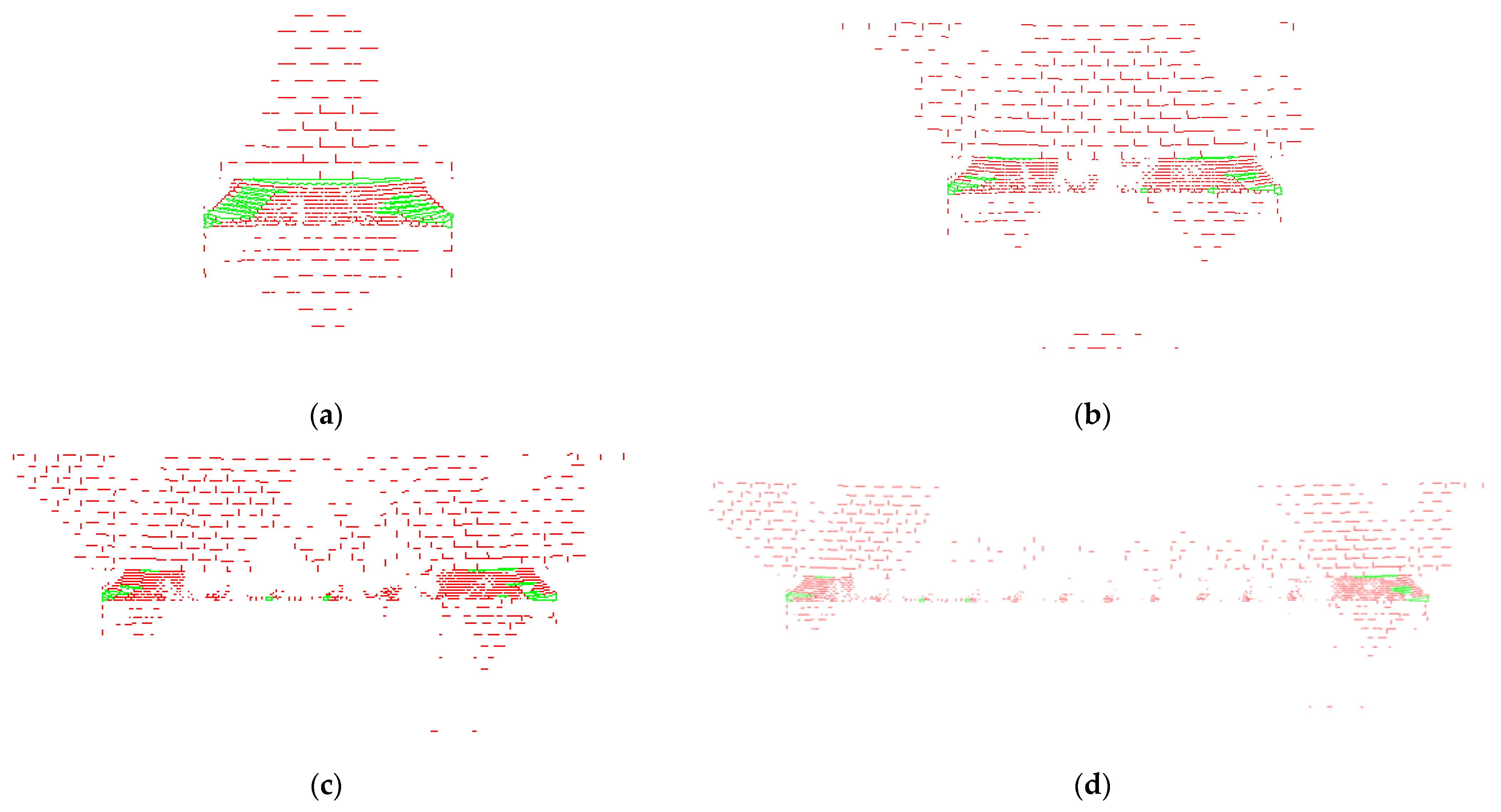
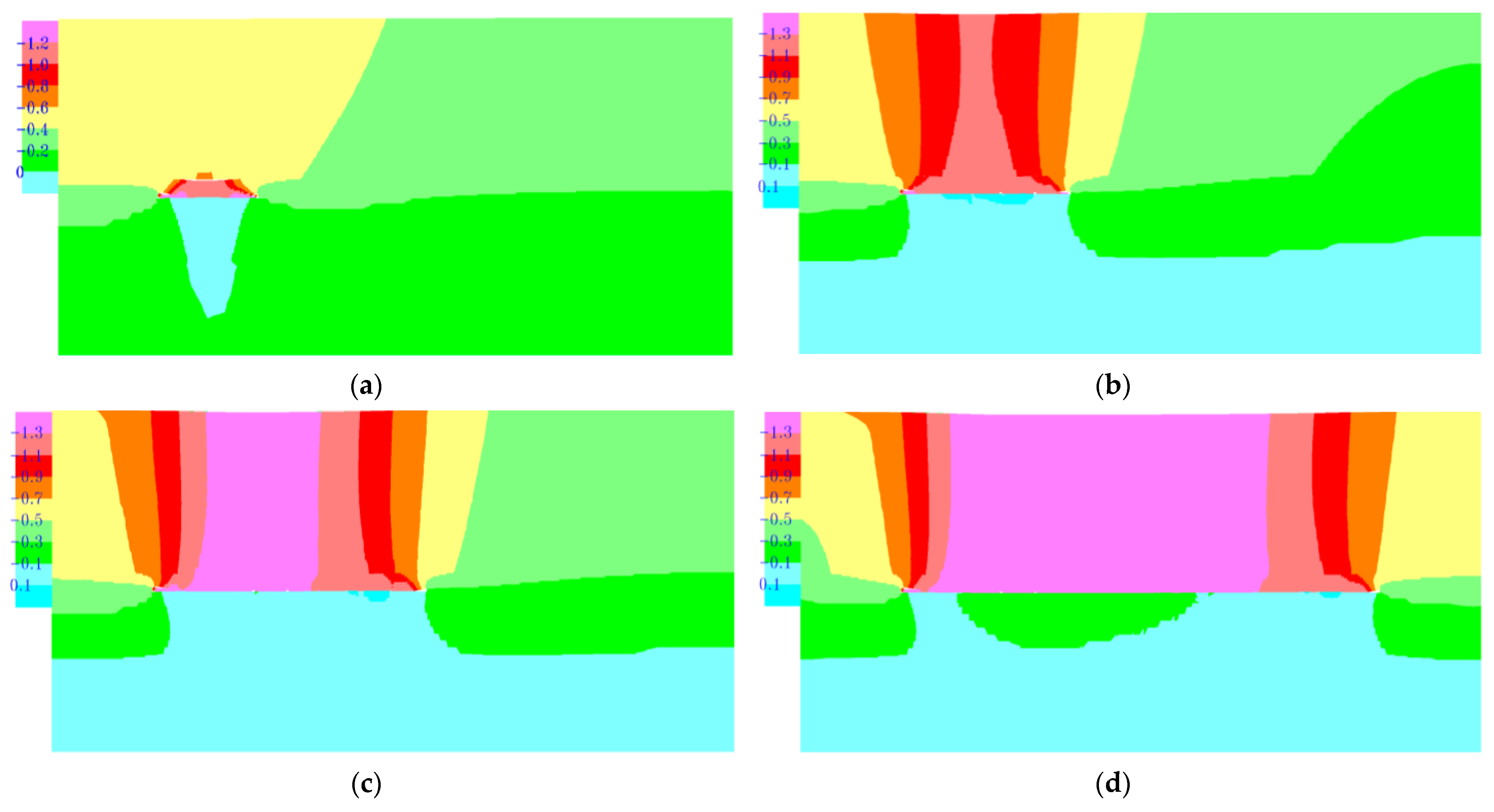

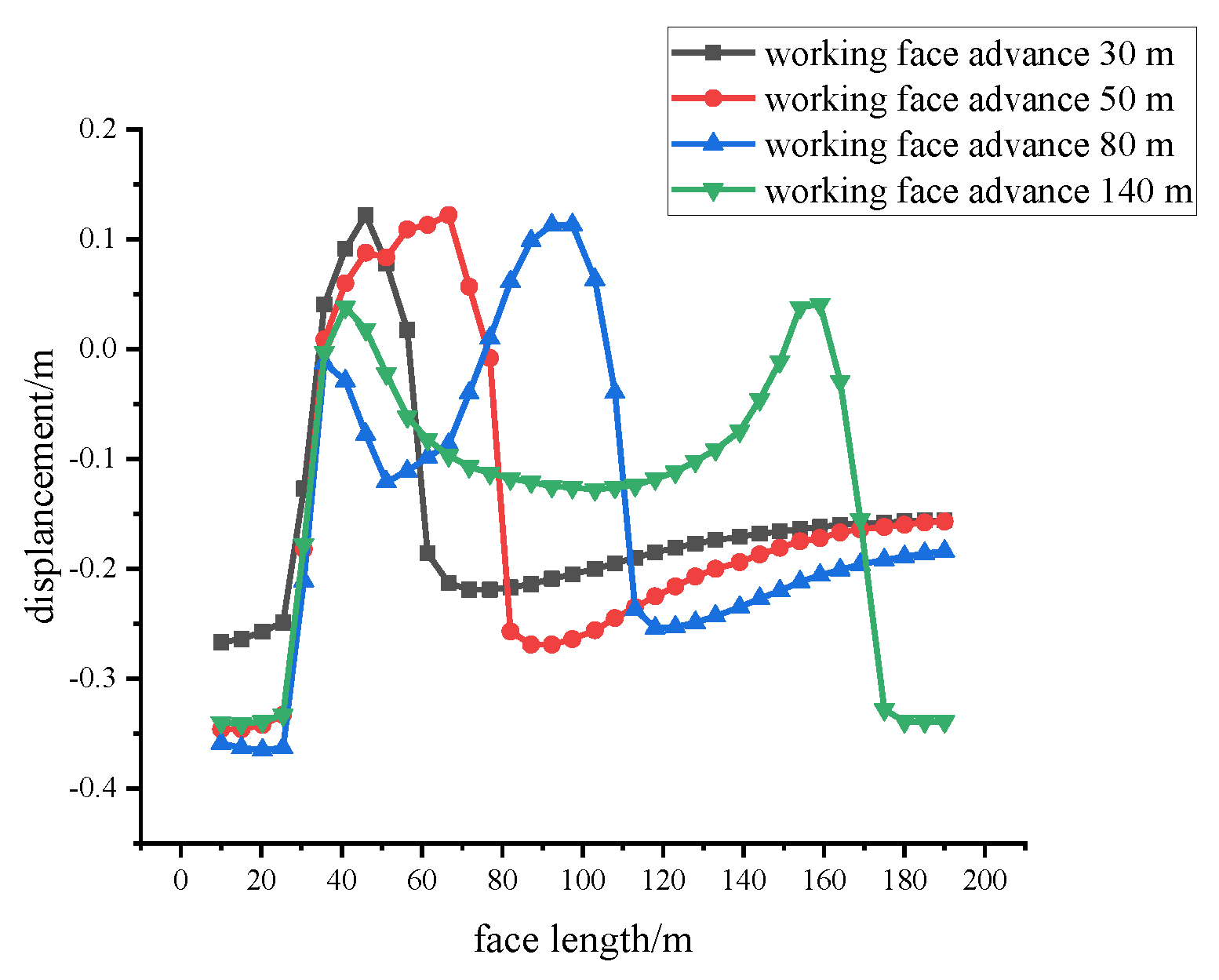
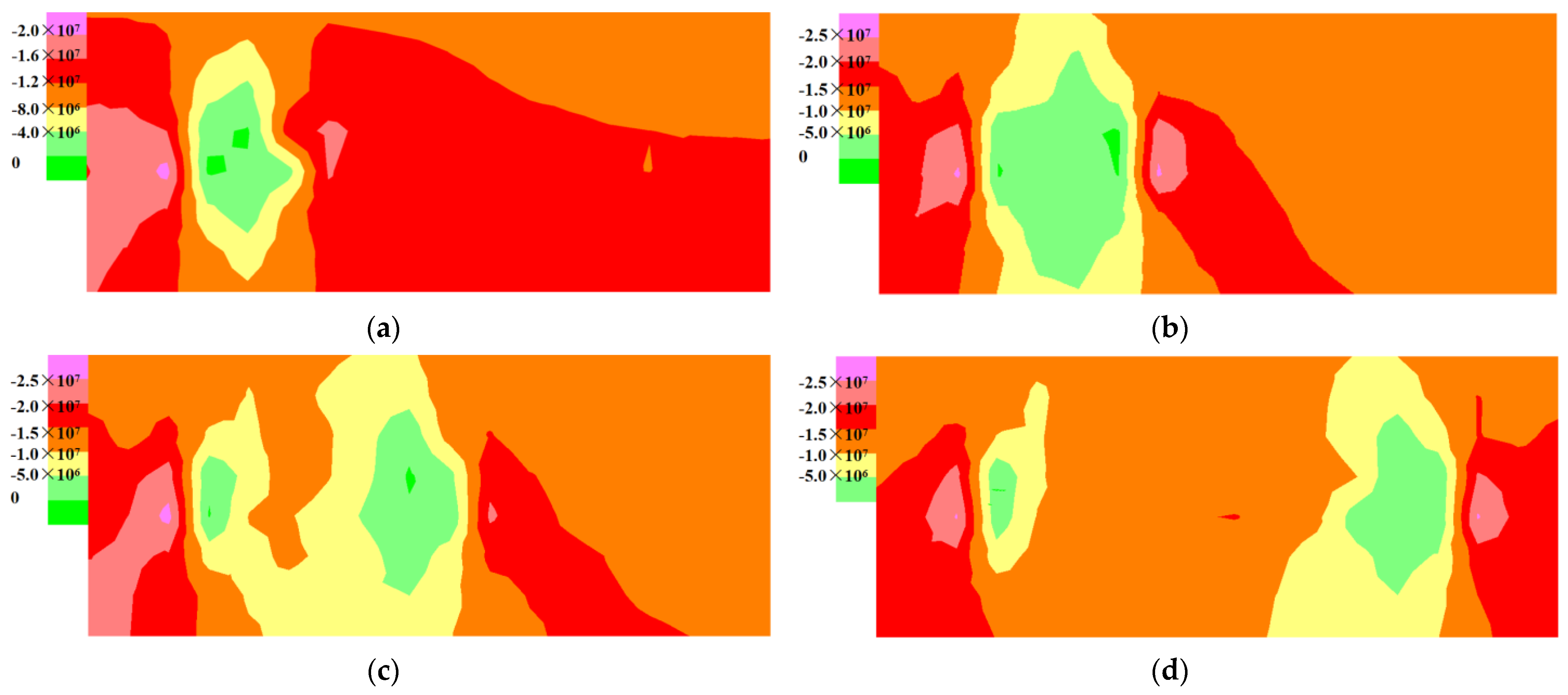
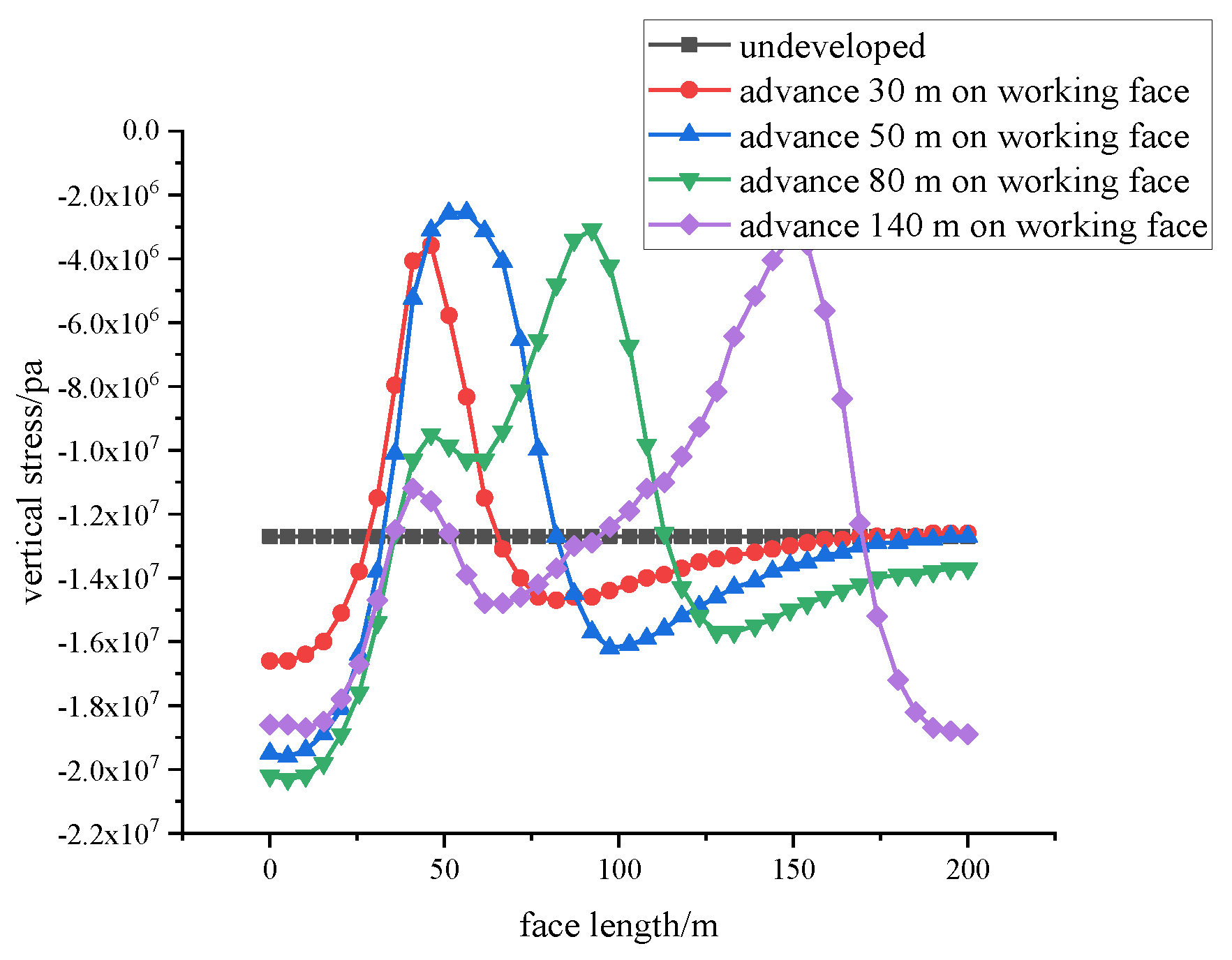
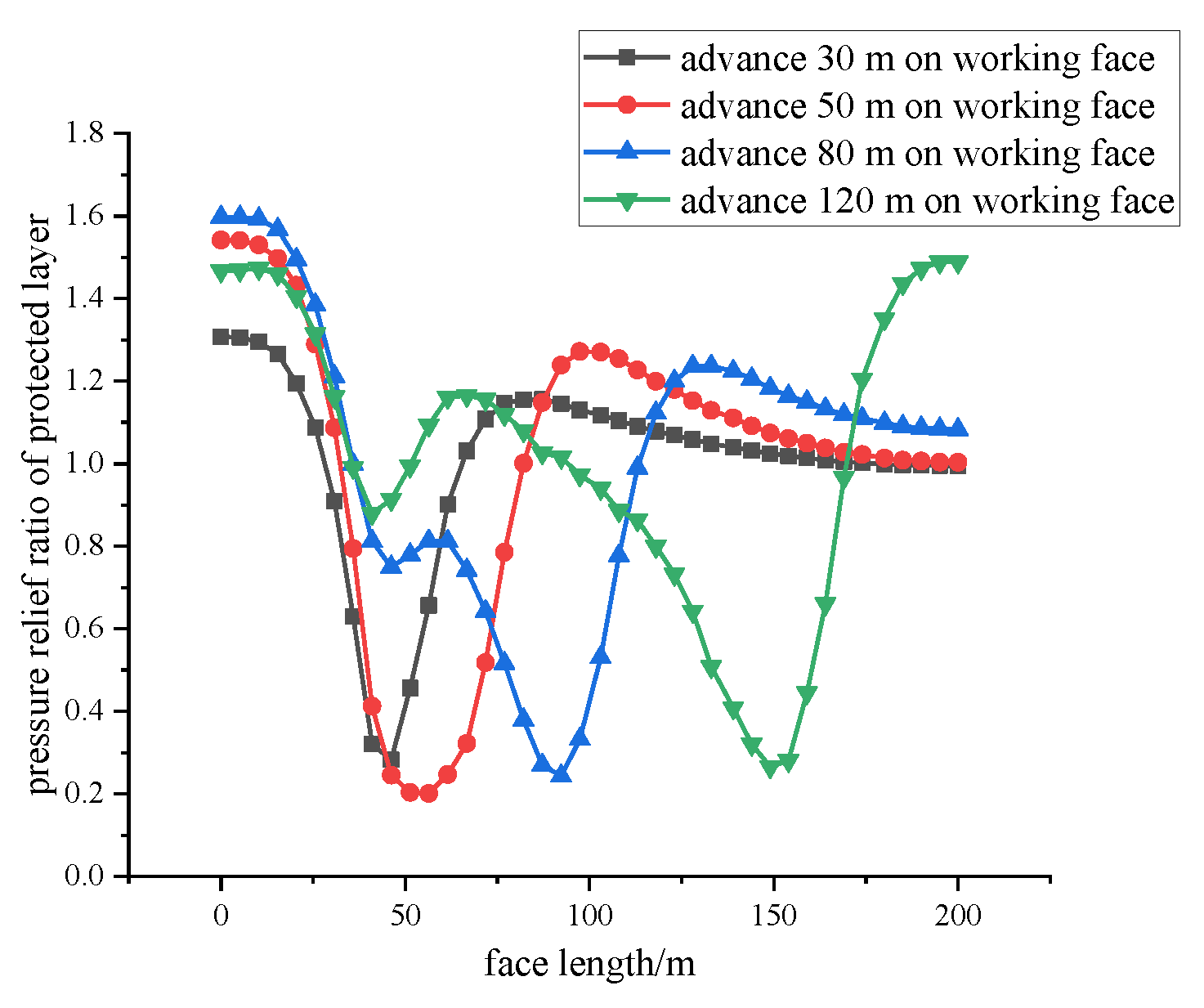
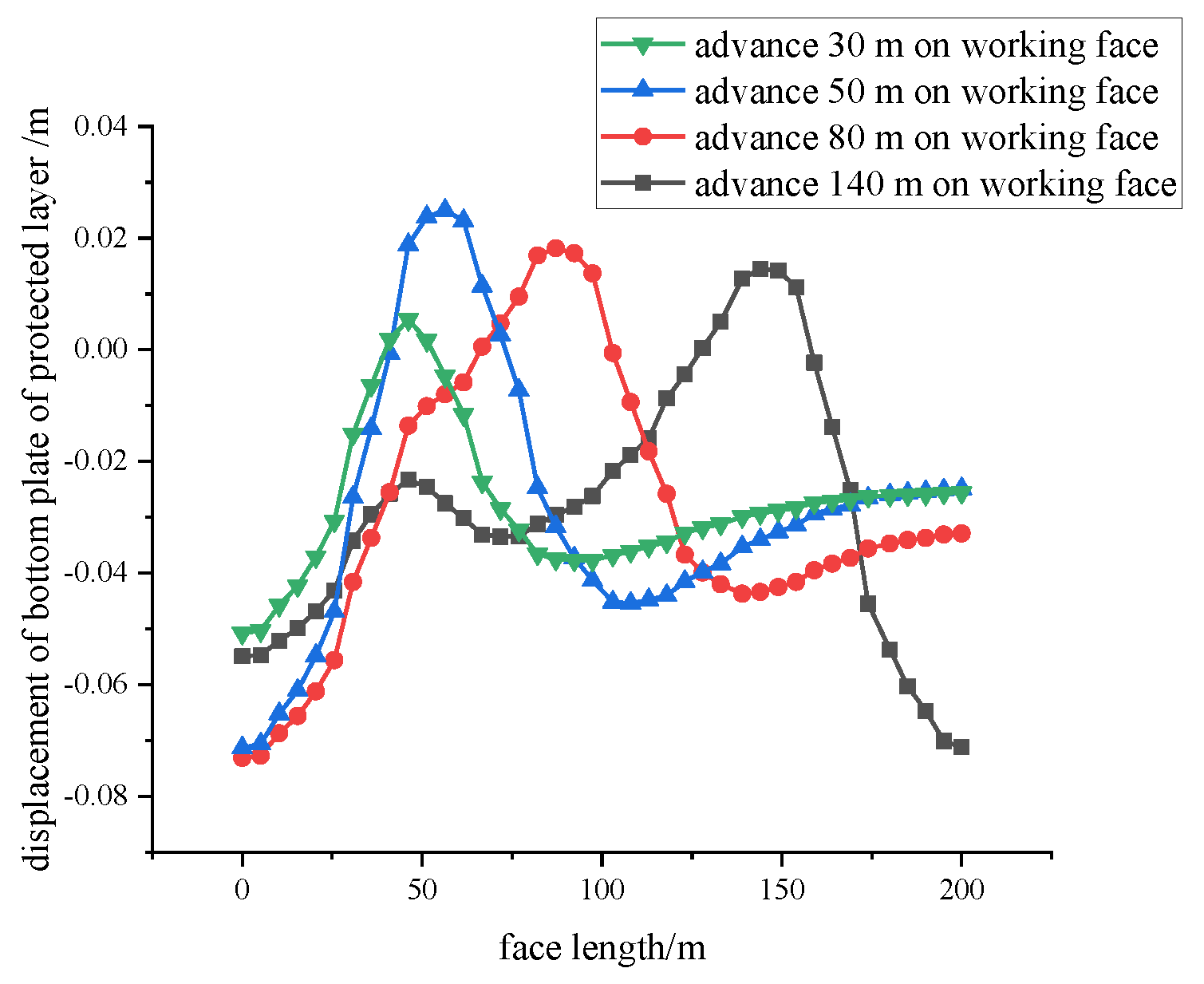

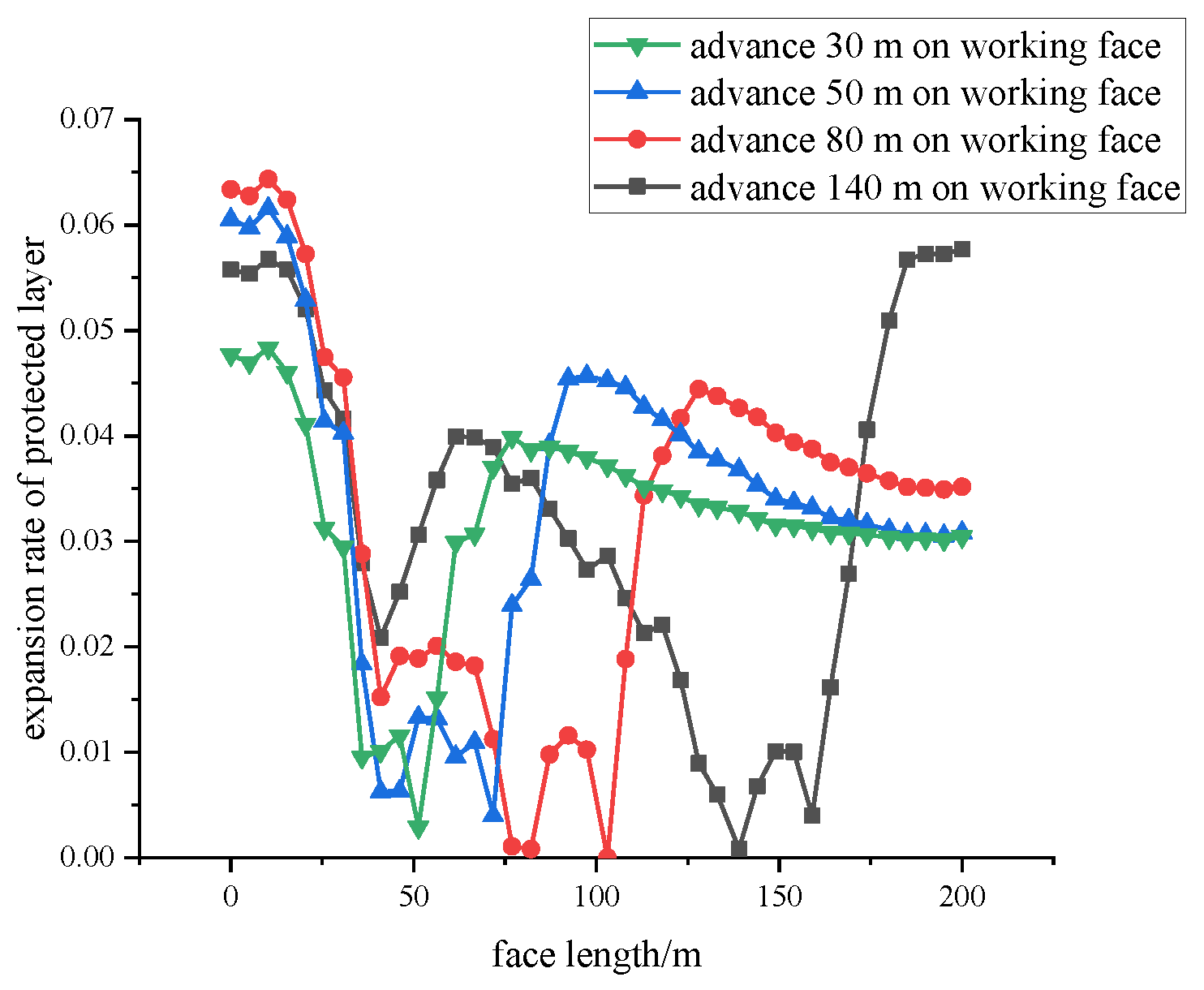
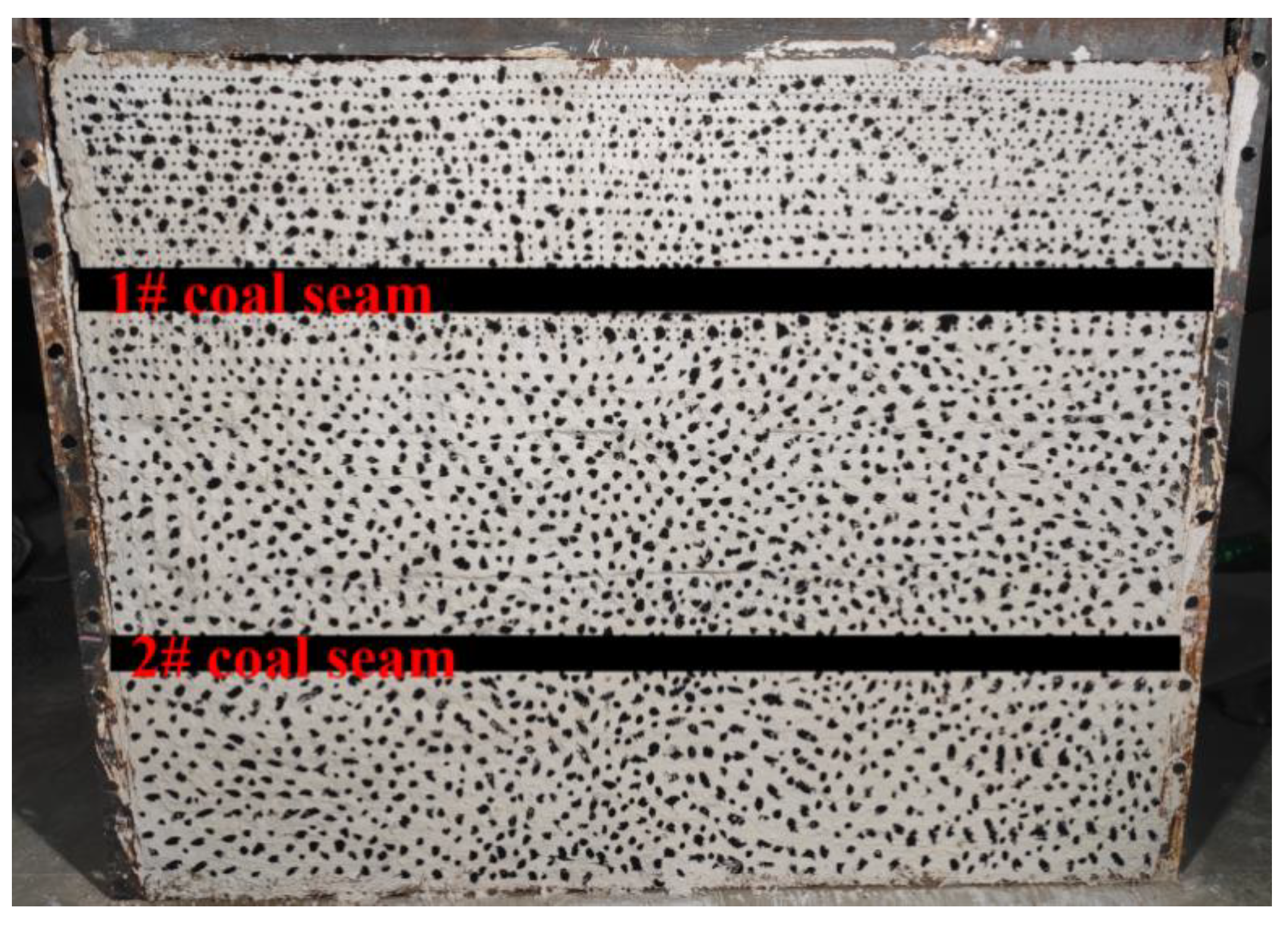
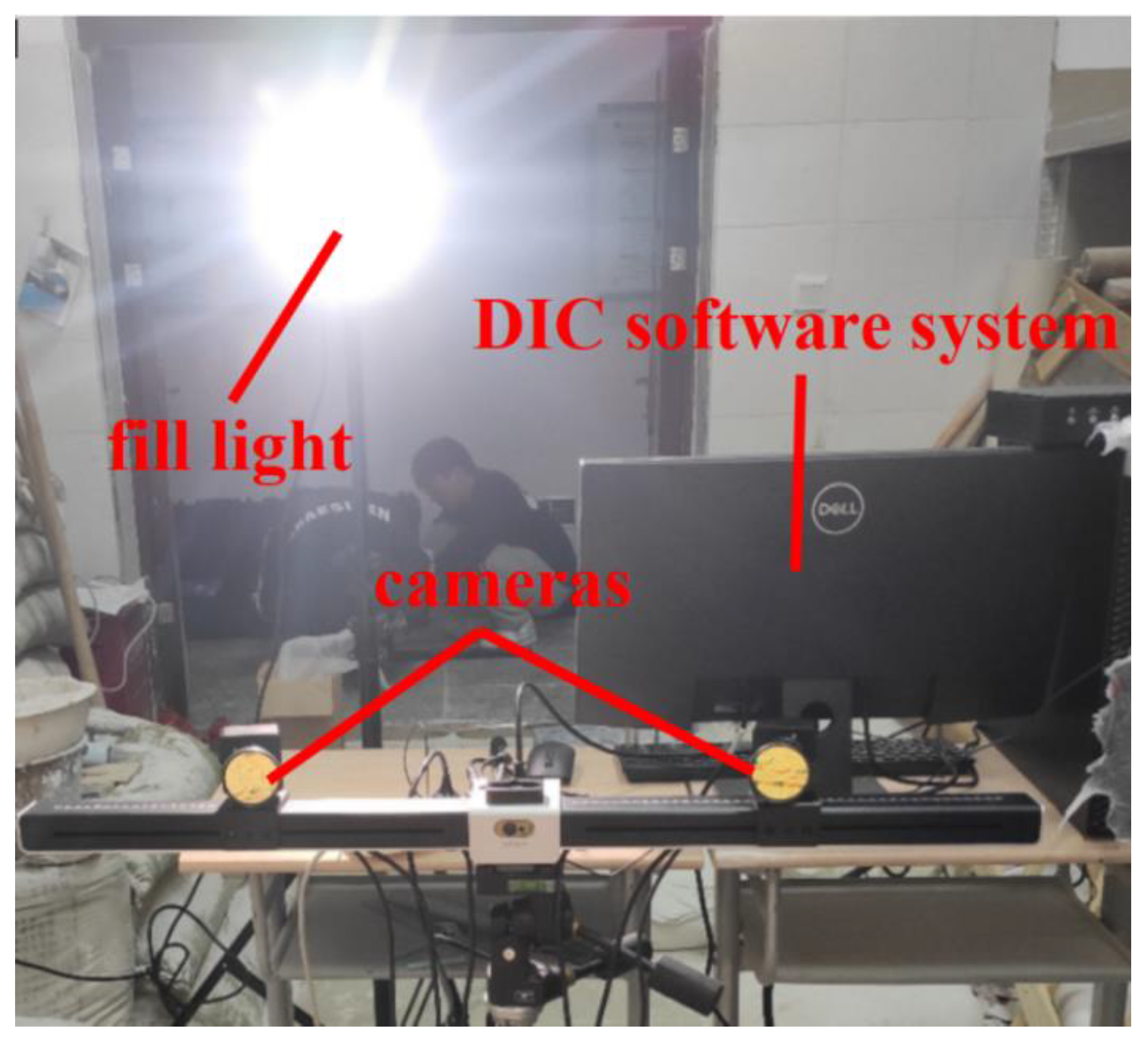
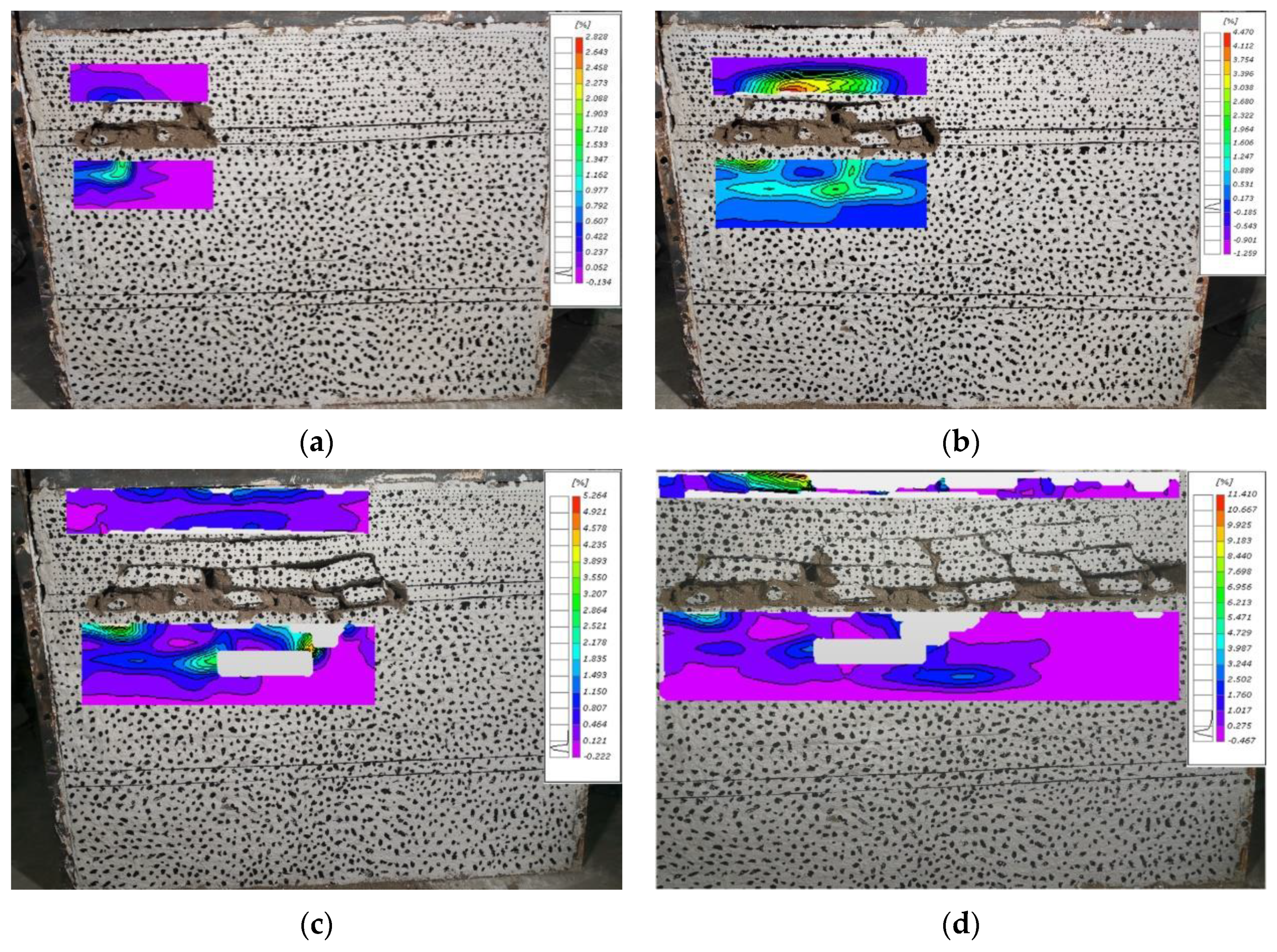
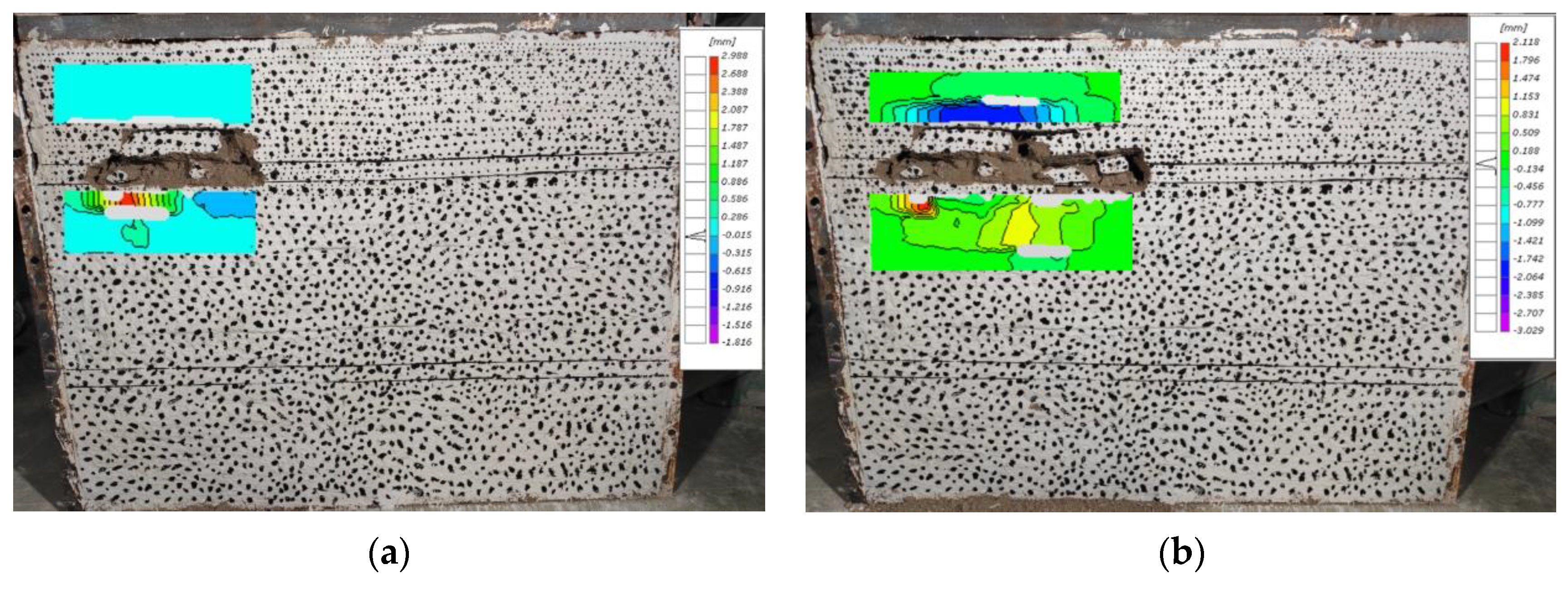

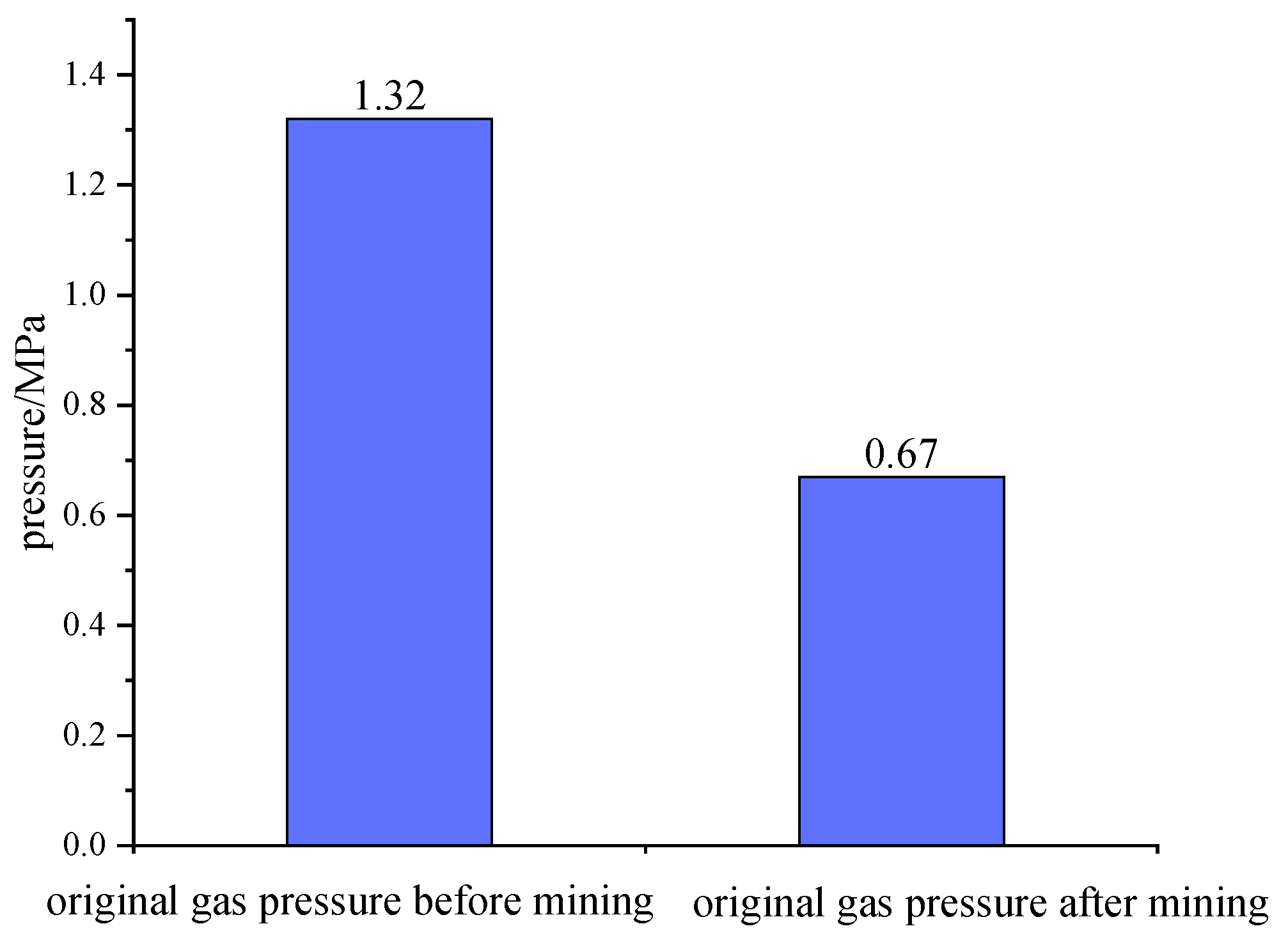

| Name of the Rock | Density (g/cm3) | Bulk Modulus (×103 MPa) | Shear Modulus (×103 MPa) | Angle of Internal Friction (°) | Tensile Strength (MPa) | Cohesion (MPa) |
|---|---|---|---|---|---|---|
| argillaceous limestone | 2300 | 1.1 | 1.95 | 32 | 1.4 | 1.4 |
| coarse sandstone | 2600 | 2.9 | 1.6 | 36 | 1.0 | 2.1 |
| mudstone | 2300 | 2.1 | 2.95 | 32 | 2.4 | 3.1 |
| 1# coal seam | 1300 | 1.3 | 0.9 | 30 | 0.8 | 0.8 |
| sandy mudstone | 2600 | 1.7 | 1.4 | 33 | 1.8 | 1.2 |
| siltstone | 2500 | 1.9 | 1.67 | 36 | 1.0 | 1.3 |
| 2# coal seam | 1300 | 1.3 | 0.9 | 30 | 0.8 | 0.8 |
| mudstone | 2300 | 2.1 | 2.95 | 32 | 2.4 | 3.1 |
| coarse sandstone | 2600 | 2.9 | 1.6 | 36 | 1.0 | 2.1 |
| Rock | Thickness (cm) | Ratio of No. | Quality of the Sand (kg) | Quality of the Lime (kg) | Quality of the Gypsum (kg) |
|---|---|---|---|---|---|
| argillaceous limestone | 10 | 655 | 37 | 3.08 | 3.08 |
| coarse sandstone | 10 | 564 | 37 | 4.44 | 2.96 |
| mudstone | 10 | 773 | 37 | 3.70 | 1.59 |
| 1# coal seam | 3 | 1055 | 11.1 | 0.56 | 0.56 |
| sandy mudstone | 6 | 773 | 22.2 | 2.22 | 0.95 |
| siltstone | 30 | 955 | 111 | 6.17 | 6.17 |
| 2# coal seam | 4 | 1055 | 14.8 | 0.74 | 0.74 |
| mudstone | 7 | 773 | 25.9 | 2.59 | 1.11 |
| coarse sandstone | 20 | 564 | 74 | 8.88 | 5.92 |
| Rock | Shear Modulus (×103 MPa) | Angle of Internal Friction (°) | Tensile Strength (MPa) | Cohesion (MPa) | Poisson Ratio |
|---|---|---|---|---|---|
| argillaceous limestone | 1.95 | 32 | 0.14 | 1.4 | 0.195 |
| coarse sandstone | 1.6 | 36 | 0.10 | 2.1 | 0.28 |
| mudstone | 2.95 | 32 | 0..4 | 3.1 | 0.25 |
| 1# coal seam | 0.9 | 30 | 0.08 | 0.8 | 0.32 |
| sandy mudstone | 1.4 | 33 | 0.18 | 1.2 | 0.278 |
| siltstone | 1.67 | 36 | 0.10 | 1.3 | 0.235 |
| 2# coal seam | 0.9 | 30 | 0.08 | 0.8 | 0.32 |
| mudstone | 2.95 | 32 | 0.24 | 3.1 | 0.25 |
| coarse sandstone | 1.6 | 36 | 0.10 | 2.1 | 0.28 |
| Borehole No | Coal Seam Gas Pressure (MPa) | Note |
|---|---|---|
| 1 | 0.66 | protected area |
| 2 | 0.67 | protected area |
| 3 | 0.62 | protected area |
| 4 | 0.69 | outside the protection area |
| 5 | 0.63 | protected area |
| 6 | 0.72 | outside the protection area |
| 7 | 0.68 | protected area |
| Borehole No | Coal Seam Gas Content (m3/t) |
|---|---|
| 1 | 3.85 |
| 2 | 2.98 |
| 3 | 3.88 |
| 4 | 5.98 |
| 5 | 3.74 |
| 6 | 4.52 |
| 7 | 3.89 |
| Month | Gas Concentration in Return Air Lane |
|---|---|
| 1 | 0.25 |
| 2 | 0.35 |
| 3 | 0.37 |
| 4 | 0.32 |
| 5 | 0.29 |
| 6 | 0.28 |
Publisher’s Note: MDPI stays neutral with regard to jurisdictional claims in published maps and institutional affiliations. |
© 2022 by the authors. Licensee MDPI, Basel, Switzerland. This article is an open access article distributed under the terms and conditions of the Creative Commons Attribution (CC BY) license (https://creativecommons.org/licenses/by/4.0/).
Share and Cite
Li, L.; Wu, G.; Liu, Q. Study on Overburden Movement and Fissure Evolution Law of Protective Layer Mining in Shallow Coal Seam. Energies 2022, 15, 1831. https://doi.org/10.3390/en15051831
Li L, Wu G, Liu Q. Study on Overburden Movement and Fissure Evolution Law of Protective Layer Mining in Shallow Coal Seam. Energies. 2022; 15(5):1831. https://doi.org/10.3390/en15051831
Chicago/Turabian StyleLi, Li, Guiyi Wu, and Qinzhi Liu. 2022. "Study on Overburden Movement and Fissure Evolution Law of Protective Layer Mining in Shallow Coal Seam" Energies 15, no. 5: 1831. https://doi.org/10.3390/en15051831
APA StyleLi, L., Wu, G., & Liu, Q. (2022). Study on Overburden Movement and Fissure Evolution Law of Protective Layer Mining in Shallow Coal Seam. Energies, 15(5), 1831. https://doi.org/10.3390/en15051831






